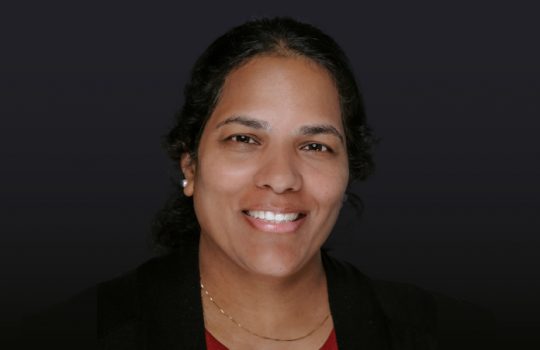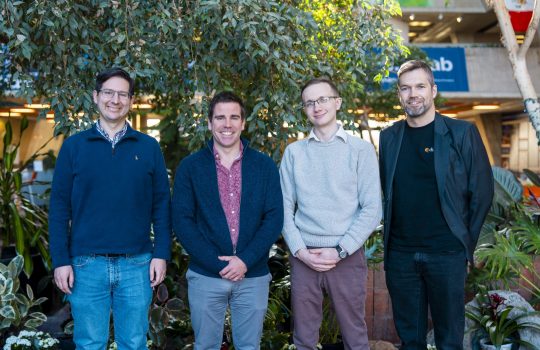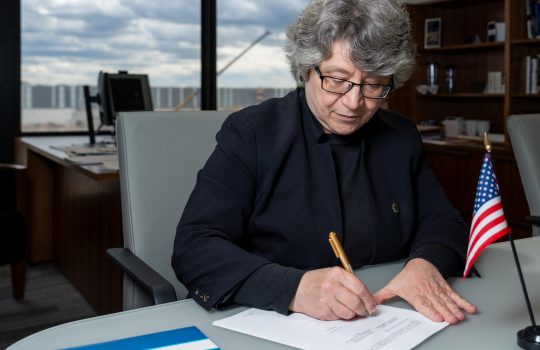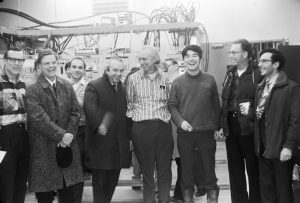
Japanese researchers have been with Fermilab from the beginning. This picture was taken on Feb. 11, 1972, when Fermilab’s Main Ring accelerator achieved 100 billion electronvolts. (Eighteen days later, its energy would double to 200 billion eV.) From left: Jim Griffin, Bob Wilson, Dave Sutter, Ned Goldwasser, Tom Collins, Shigeki Mori, Ed Hubbard, Ernie Malamud. Photo: Ryuji Yamada
It was 1971, and Fermilab was unexpectedly in a crisis: The magnets in the newly constructed Main Ring were shorting out daily. Engineers repaired the magnets during the day, allowing physicists to attempt tuning the beam at night. After many weeks of diligent work, the team achieved a circulating beam.
But they ran into another second stumbling block: While they could accelerate the beam easily up to 10 billion electronvolts, they hit a wall at higher energies, setting off another couple weeks’ worth of nose-to-the-grindstone work. The cause of the rampant failures had proved mystifying.
Ryuji Yamada accompanied a welder to a malfunctioning magnet. “I just watched the repair process,” recalled Fermilab’s first Japanese researcher. The welder cut through the vacuum pipes between the magnets. Yamada noticed stainless steel slivers falling to the floor. He collected the slivers and examined them back at his office. They turned out to be stainless slivers with greatly increased magnetic permeability.
“Although welders cleaned the inside the vacuum pipe, they could not do a perfect job,” he said. “At low field, the slivers were lying down inside the pipe, but when the magnetic field increased they were sucked inside the magnet gap and stood up and stopped the beam.”
One cleaning regimen overhaul later, the Main Ring was restored to full operation, achieving the goal of a 200 billion-electronvolt beam within five years, as originally planned by founding Director Robert Wilson. Over the following years, the beam met, then exceeded, the goals. And so did the influence and impact of physicists from Japan.
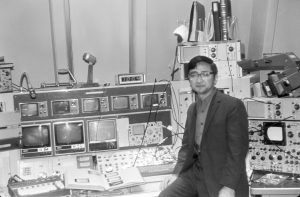
Ryuji Yamada is one of the scientists who, in 1972, helped the Main Ring accelerator achieve 100 and up to 200 billion electronvolts. In this picture, 100 billion electronvolts is indicated in the meter just above the controls. Photo: Fermilab
Throughout the 1970s, Yamada continued his critical contributions to Fermilab’s high-energy physics program. Director Wilson had begun a project for developing superconducting magnets for the Energy Doubler, which was later assigned a more ambitious beam energy goal of 1 trillion electronvolts and renamed the Tevatron. So Yamada got to work, starting a new superconducting magnet testing group for Tevatron magnets. Masayoshi Wake, a scientist at the Japanese high-energy physics laboratory KEK, also contributed substantially to the project. Together, they forged inroads for a collaboration that would soon be formalized.
In 1978, Japan hosted the International Conference on High Energy Physics in Tokyo. Leon Lederman, who would take over as Fermilab director the following year, talked with KEK Director Tetsuji Nishikawa on future collaboration, including the Tevatron Collider project.
DOE signed a formal collaboration with Japan on November 11, 1979. The deal was an opportunity for Japan to grow its high-energy physics experimentalist community, with an end goal of investing more homegrown talent into expanding KEK. In an effort led by scientist Kuni Kondo, Japan formed the initial CDF collaboration with Italy and the United States and remained heavily involved in the Tevatron collider throughout its 30-year run, as well as the CDF detector, from constructing detector components, to analyzing jets, and taking leading roles in the top quark and Bc meson discoveries. Scientist Shigeki Mori, who helped the Main Ring reach an energy of 200 billion electronvolts, was one of the early contributors to this effort.
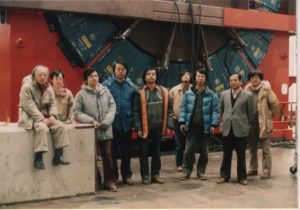
Scientists from the University of Tsukuba and KEK stand in front of the CDF detector in 1984 at Fermilab. From left: Shoji Mikamo, Yoshio Hayashide, Akihiro Yamashita, Hitoshi Miyata, Kiyoshi Yasuoka, Taku Yamanaka (KTeV experiment), Shinhong Kim, Kuni Kondo, Yoshinobu Takaiwa. Photo courtesy of Shinhong Kim
One member of this cohort was Taiji Yamanouchi, who served as an assistant director and head of the Fermilab program planning office. Before the U.S.-Japan collaboration began, he was part of a group led by Lederman that discovered the Upsilon particle in 1977 using the Main Ring beam. (The Upsilon particle is made of a bottom and antibottom quark.)
About 20 other Japanese researchers were on site at any given time, creating a prominent community in Wilson Hall, where they had lunch together frequently. One of these other researchers was Shinhong Kim, who joined CDF in 1980 and became the CDF Japanese group leader in 2000.
“Japanese researchers contributed to the construction of the detectors and the physics analysis in each U.S.-Japan project, such as CDF, E704, E782, KTeV, DONUT, SciBooNE and so on,” said Kim, a professor at the University of Tsukuba. “They brought in unique detector technology and new analysis methods into the collaboration. In these projects, we saw that the diversity made the collaboration more fruitful.”
Approximately 50 Japanese researchers earned Ph.D.s through their work at Fermilab, and many of them, as originally planned, have used their expertise to build other international research endeavors.
Kim, for example, now collaborates with Fermilab as leader of the Japanese-led cosmic background neutrino decay (COBAND) experiment. COBAND hopes to see far into our universe’s past by finding neutrinos formed shortly after the Big Bang, similar to studies on the cosmic microwave background radiation. Under Kim’s guidance, the project is currently developing superconducting far-infrared photon detectors.
About half of the 55 current members of the Japanese users community at Fermilab work from their own institutions like Kim. Those on site are not concentrated in one area of the lab as they once were at CDF. Rather, they now participate in 11 different projects or experiments.
The future for U.S.-Japan partnership remains bright. The 1979 agreement is renewed annually when representatives gather to discuss project updates, future funding and new ideas.
The 30th Anniversary Symposium of the U.S.-Japan Collaboration in High Energy Physics was held in Hawaii on Oct. 20-21, 2010. The proceedings of the symposium show further details of the collaboration.

